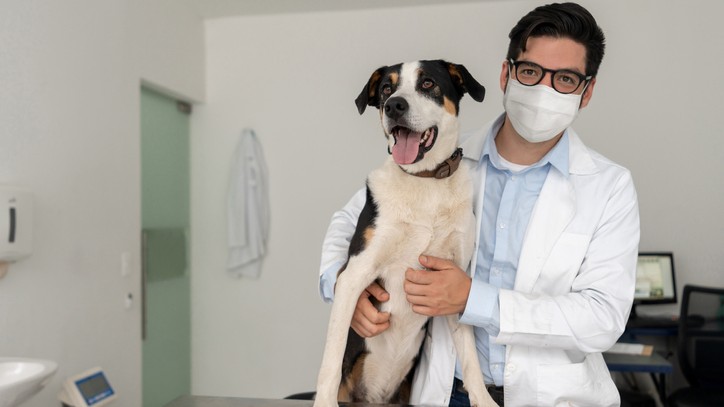How to identify a pet emergency: A vet’s advice on when to call the vet
Do you need to go to the pet emergency clinic or can it wait until your veterinarian’s office opens in the morning?

While every pet owner hopes they will never experience a pet emergency, it can happen to any of us. If your pet develops an illness or injury, you will need to quickly make some decisions. Does your pet require immediate, emergency care or can you call your veterinarian’s office to schedule an appointment? If it is an emergency, should you go to your regular veterinarian’s office or an emergency animal hospital? Will the best pet insurance policy you could find cover the expense? Your veterinarian’s office is likely equipped to handle many common daytime emergencies, but after-hours emergencies or critically ill pets may need to be treated at the emergency hospital.
Emergency care options for pet owners
In most cases, daytime emergencies are seen by general practice veterinarians. In some cases, however, a practice may refer a daytime emergency to an emergency hospital. This can happen for a number of reasons: the practice’s only veterinarian is tied up in a lengthy surgery and your pet requires immediate treatment, the practice is short-staffed and cannot give your emergency the attention it needs, or your pet’s condition sounds critical and your pet would be better served at an emergency hospital. Therefore, it’s always best to call your veterinarian before showing up with an emergency.
Veterinary emergency hospitals work like human emergency rooms. They offer after-hours care when general practices are closed, as well as having the staff and supplies to treat the most critical patients. Emergency hospitals are typically open 24 hours a day and are often staffed by specialists, who have extensive training and experience in addressing complicated medical and surgical conditions. You may have a wait, similar to a human emergency room, but patients are typically triaged and seen in the order of their case severity; a critically-ill pet will likely be seen right away, while a mild injury may need to wait as more critical patients are treated first.
In some rural areas, veterinary emergency hospitals may not be available. Your veterinarian may be on-call for after-hours emergencies, or share on-call duties with other local veterinarians. Talk to your veterinarian about emergency care options in your area.
Eight signs your pet needs an emergency vet
When your pet develops an illness or injury and your veterinarian’s office is closed, it can be hard to decide whether to go to the emergency hospital or wait for your regular veterinarian to re-open in the morning. When making this decision, it’s helpful to know what constitutes a true emergency.
While no list can prepare you for every single scenario, most common pet emergencies fall into one of the following categories:
1. Bleeding
Heavy bleeding, bleeding that lasts more than 5-10 minutes, or significant bleeding from the mouth or nose should be regarded as an emergency. Minor bleeding that resolves within a few minutes, like a small cut or scrape, can probably be monitored at home until the following day, unless it is associated with a laceration or other wound that needs to be repaired
Get the best advice, tips and top tech for your beloved Pets
2. Breathing difficulties
If your pet is choking or struggling to breathe, this is an emergency and requires immediate care.
3. Eye injury
Any significant injury to the eye is an emergency, because it could cost your pet his vision. Mild squinting or redness can wait until your veterinarian’s office opens the following day, but should always be treated within 24 hours.
4. Inability to urinate or defecate
If your pet is straining to pass urine or stool and is unable to do so, this is a medical emergency. Male cats are especially prone to urinary obstructions, which can be life-threatening if not detected and treated quickly.
5. Lameness
Mild lameness can often wait until your veterinarian’s office opens pain, but a very painful, acute injury warrants an emergency visit. An emergency veterinarian can prescribe pain medication to be used until your pet receives more definitive treatment.
6. Neurologic signs
If your pet becomes unconscious, has a seizure, or appears to be paralyzed in some or all of the limbs, seek veterinary care immediately.
7. Toxin ingestion
If your pet has ingested a potential toxin, such as antifreeze, xylitol (artificial sweetener), or chocolate, seek emergency care immediately. It’s important to remove potential toxins from your pet’s body as soon as possible.
8. Vomiting or diarrhea
While a single episode of diarrhea can typically wait until your veterinarian’s office opens the next day, severe vomiting or diarrhea require emergency care. Your pet can become dehydrated from severe or repeated episodes of vomiting or diarrhea.
While these are helpful guidelines, it’s also important to trust your gut. If you have any doubts about whether your pet’s condition warrants a trip to the emergency hospital, call the emergency hospital for guidance.

Be prepared
The last thing you want to do in an emergency is having to rush around to gather information. Take some time to make a note of the following information in advance:
- Your veterinarian’s telephone number
- Your local veterinary emergency hospital’s telephone number and location
- The ASPCA’s Animal Poison Control telephone number: 888-426-4435

There’s no NHS for pets. Veterinary care can be eye-wateringly expensive and most pets will need treatment for an illness or injury at some point in their life. It’s difficult to think about your animals being hurt or unwell, but you need to ask yourself: what would you do if you were faced with a vet bill for hundreds or thousands of pounds?
Consider assembling a basic pet first aid kit. This should include bandages that you can use to stop bleeding, a leash or carrier, and a muzzle in case your pet is painful and attempting to bite.
Finally, consider how you will pay for your pet’s care in an emergency. Pet emergencies can cost thousands of dollars and payment is typically required at the time of service. Even though you likely hope you will never have an emergency, it’s important to plan ahead for the possibility. Our list of five things to look out for when shopping for the best policy will help. Pet insurance, a dedicated pet emergency fund, or credit cards with available credit can all be viable options for paying for emergency care. Think through these options in advance so that you will be prepared if and when an emergency arises. It might also help to find out how to get cheaper pet insurance.
Don't panic
While it can certainly be distressing to witness a pet emergency, try to remain calm. Panicking rarely leads to productive action. Instead, take a deep breath, determine whether your pet’s condition requires immediate care, and then call your veterinarian or your local emergency hospital for guidance.
Dr. Barnette is a graduate of the University of Florida, where she received both her B.S. in Zoology and her Doctor of Veterinary Medicine (DVM). She has 15 years of clinical experience as a small animal veterinarian, treating dogs, cats, and occasional exotic patients. She now works as a freelance veterinary writer, creating educational content for veterinarians, veterinary team members, and dedicated pet owners. Dr. Barnette lives in southwest Florida with her husband and daughter (plus two cats, a dog, and a rescued dove!) and enjoys kayaking, biking, and hiking. Learn more about Dr. Barnette at www.linkedin.com/in/catherinebarnette.

